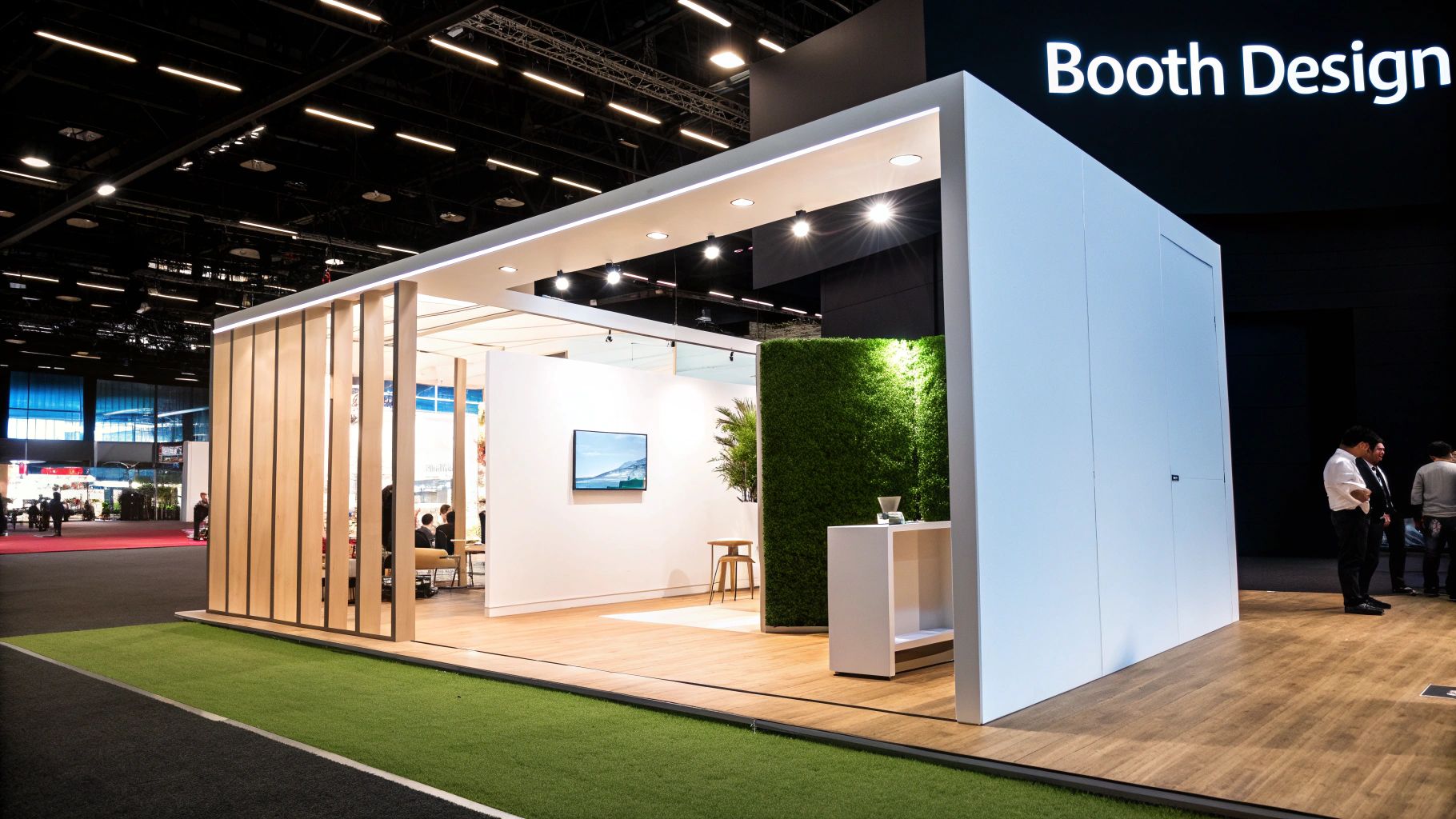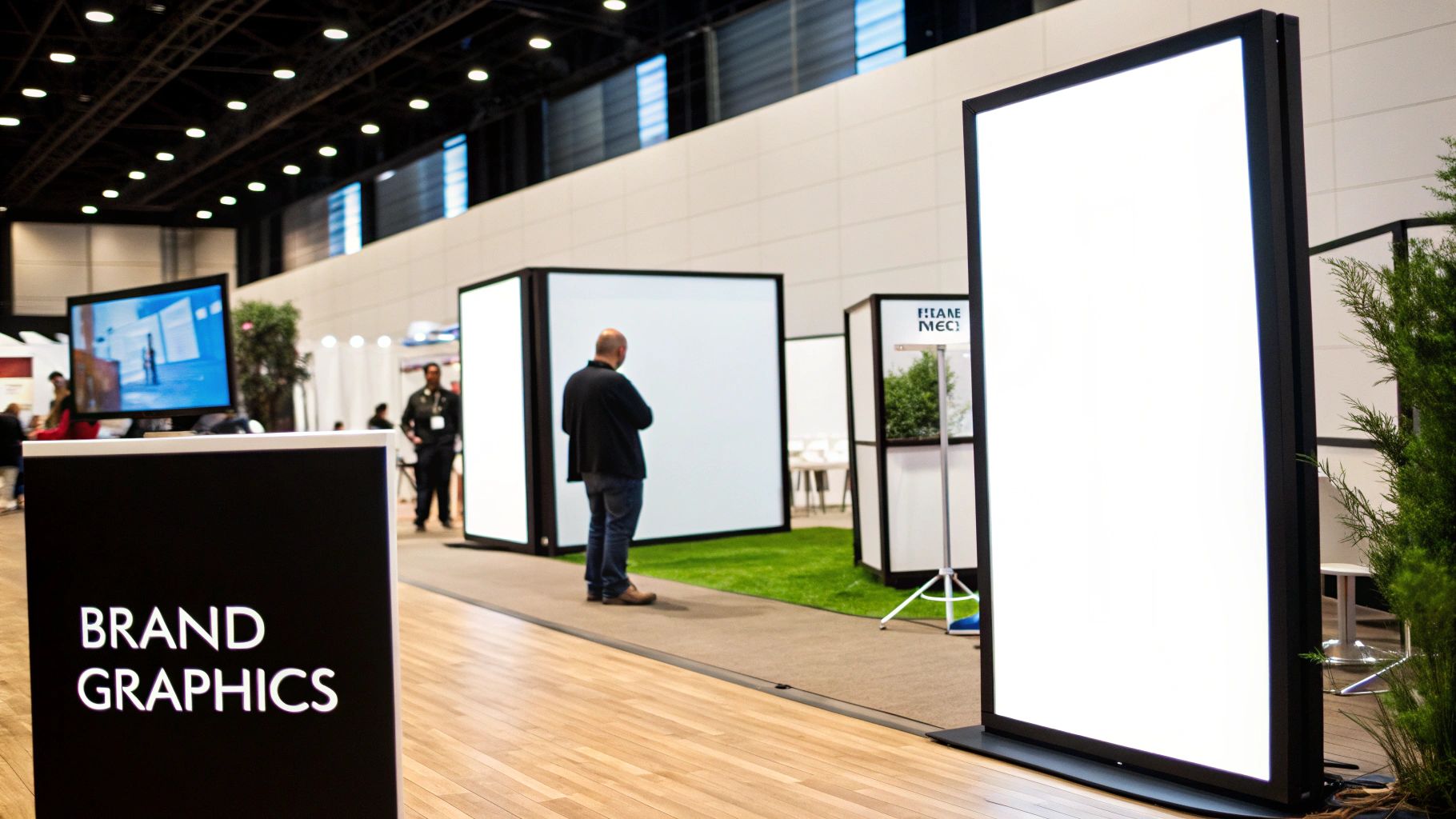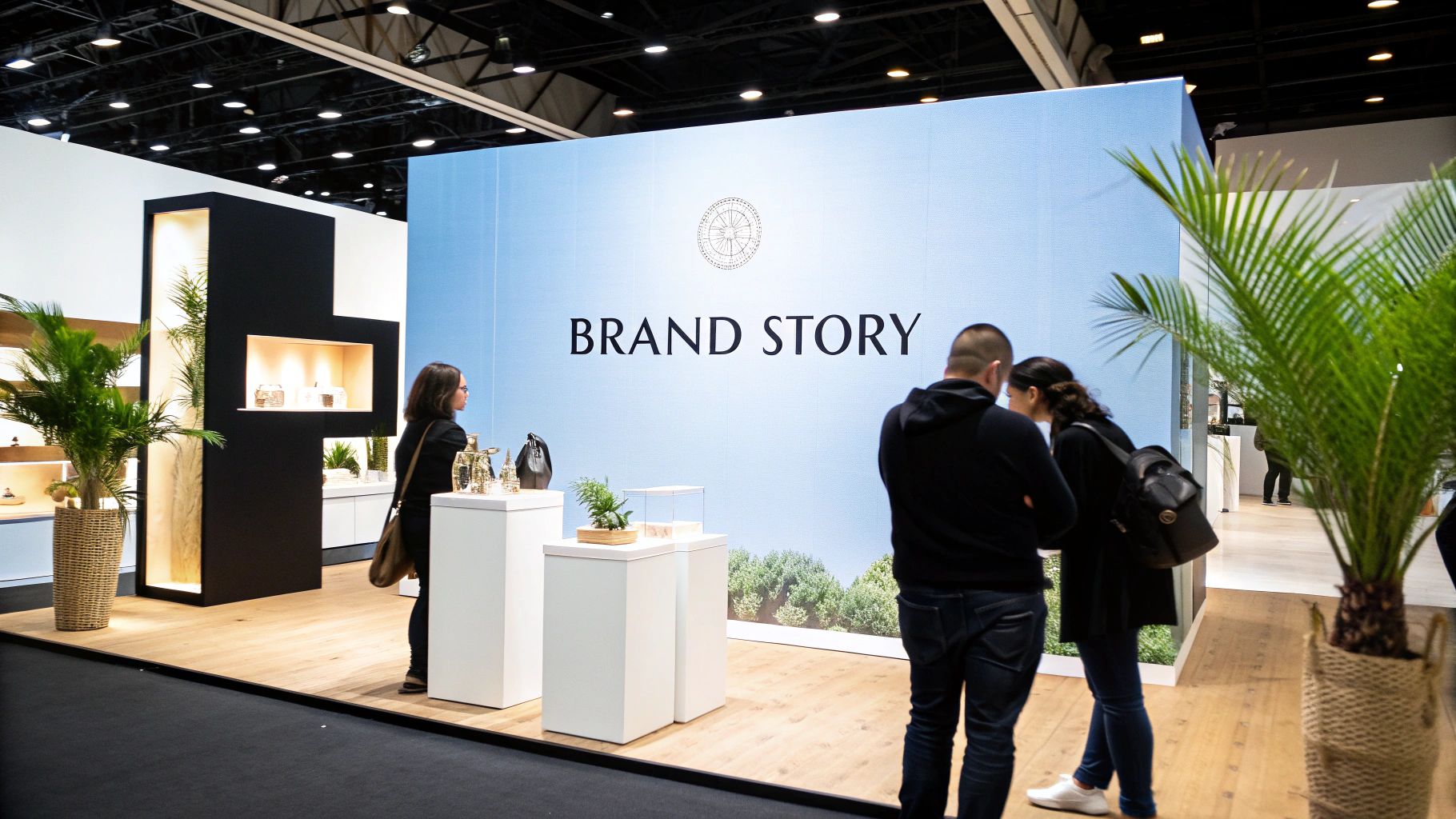Trade Show Branding: Captivate & Convert Leads
The Hidden Power of Trade Show Branding

In today's marketing world, digital strategies often dominate. It's easy to forget the impact of real-world connections. However, trade shows offer a unique opportunity to forge tangible relationships that online campaigns struggle to replicate. This personal touch is why many companies continue to invest in physical events, recognizing the hidden power of trade show branding.
Consider the effect of a well-designed, visually appealing booth. The act of physically engaging with a brand, touching products, and talking with representatives creates a sense of trust and familiarity. This is something a website or social media post simply can't achieve. It helps build lasting brand recognition that extends far beyond the event itself.
There's also a scientific reason for the lasting impact of physical brand experiences. Studies suggest in-person interactions create stronger memories than digital ones. This is due in part to the multi-sensory engagement of live events, stimulating sight, sound, and touch simultaneously. This increased sensory input means attendees are more likely to remember your brand, even in the bustling environment of a trade show.
Brand Awareness and Recognition
Trade show branding is essential for businesses looking to boost their visibility and brand awareness. In fact, nearly 88% of businesses attend trade shows with the primary goal of increasing brand awareness. And this strategy works. Around 76% of exhibitors report increased brand recognition after participating in trade shows. Impressively, 81% of attendees recall at least one exhibitor they interacted with even six months after the event, showcasing the enduring effect of face-to-face connections. More statistics can be found here: Trade Show Statistics.
This lasting impression translates directly into tangible business results. Increased brand awareness leads to higher lead generation, stronger customer relationships, and ultimately, improved sales. While digital marketing remains a vital component of a modern marketing approach, the power of in-person engagement at trade shows is undeniable. Investing in a strong trade show presence provides a powerful way to connect with your target audience, build enduring relationships, and drive significant business growth.
Crafting Exhibit Experiences That Actually Convert

What makes a trade show booth truly memorable? It's the creation of engaging experiences that resonate with attendees and clearly communicate your brand message. This involves strategically blending spatial design, impactful visuals, and interactive elements to stand out in the busy exhibition hall. Consider, for example, how the booth's layout can guide visitors through your brand story and encourage a natural flow.
This thoughtful approach creates opportunities for meaningful connections and impactful brand interactions.
The psychology of memorable trade show environments is key to converting attendees into leads. Sensory branding, through elements like lighting, color schemes, and even subtle scents, can subconsciously influence visitor perception. This creates a positive emotional connection with your brand. Crafting a multi-sensory experience is crucial for leaving a lasting impression.
Strategically placed product displays can further enhance engagement by allowing attendees to interact directly with your offerings.
Optimizing Visitor Flow and Engagement
Successful trade show branding finds the right balance between aesthetics and functionality. Award-winning exhibits often feature open, inviting spaces that encourage exploration. They also incorporate designated areas for private consultations and product demonstrations.
This approach creates a comfortable atmosphere while catering to different engagement styles, ultimately maximizing visitor dwell time. By analyzing visitor flow patterns, you can optimize booth layout. Guide prospects through a pre-planned journey showcasing your key offerings and brand narrative.
This ensures a cohesive brand message and encourages visitors toward a desired conversion point.
The post-pandemic landscape has significantly changed how brands approach trade shows. While virtual events briefly gained popularity, the overwhelming majority of exhibitors (95%) still prefer in-person engagements. This preference is reflected in the impressive growth of the global exhibition industry, projected to surpass pre-pandemic values by 2026. In the United States alone, the B2B trade show market is expected to reach $15.8 billion in 2024. More detailed statistics can be found here: Trade Show Statistics.
This underscores the enduring value of face-to-face interaction for building brand awareness and driving conversions. Optimizing your physical presence at trade shows is crucial for capitalizing on this renewed interest.
Creating Visual Hierarchy and Product Placement
Effective visual hierarchy draws the eye and instantly communicates key messages. Bold graphics, clear signage, and strategic lighting create focal points and highlight important information. Avoid overwhelming attendees with excessive visual stimuli.
Instead, prioritize a clear visual hierarchy. Emphasize your brand logo, key messaging, and product highlights. This ensures attendees quickly understand your core offerings and leave with a strong brand impression.
Product placement is equally important. Your booth should function like a retail space. Carefully positioned products tell a story. Interactive displays, demonstrations, and even gamification encourage deeper engagement.
Connect your product display to your brand’s overall story. By seamlessly weaving your product into the narrative, you create a more meaningful interaction. This transforms passive observers into active participants.
Let's explore some key elements in more detail:
To further illustrate these points, consider the following table:
Essential Elements of Effective Trade Show Booths A comprehensive comparison of critical design elements that make trade show booths successful
| Design Element | Purpose | Implementation Tips | Common Mistakes |
|---|---|---|---|
| Spatial Design | Optimize flow and encourage engagement | Use an open layout, define specific areas for consultations, and guide visitors through a narrative. | Creating a cluttered or confusing layout that hinders movement and interaction. |
| Visual Hierarchy | Draw attention and communicate key messages | Use bold graphics, clear signage, and strategic lighting to highlight key information. | Overwhelming attendees with too much visual stimuli or failing to emphasize key branding and product highlights. |
| Product Placement | Showcase products and encourage interaction | Create interactive displays, demonstrations, and incorporate gamification. Integrate product displays into the brand narrative. | Passive product displays that fail to engage attendees or connect with the brand story. |
| Sensory Branding | Enhance the visitor experience and create a positive emotional connection | Utilize lighting, color schemes, and even subtle scents to create a memorable atmosphere. | Neglecting the impact of sensory elements on visitor perception and brand association. |
This table summarizes the crucial design elements for creating an impactful trade show presence. By incorporating these principles, you can develop booths that deliver results. Ensure your investment translates into tangible business outcomes.
Pre-Show Momentum: Building Anticipation That Drives Traffic

Savvy exhibitors know that effective trade show branding begins well before the event itself. Generating pre-show excitement is essential for driving traffic and maximizing your return on investment. This involves strategically building anticipation within your target audience weeks in advance. Think of it as a movie premiere – marketing efforts create a sense of anticipation, driving ticket sales before the opening day.
One key strategy is a multi-channel outreach campaign. This uses a combination of email marketing, social media engagement, and even targeted advertising to connect with potential attendees. For instance, a series of emails could showcase key products or services, while social media offers sneak peeks of your booth or exclusive behind-the-scenes content.
This consistent communication keeps your brand top-of-mind and generates excitement. However, timing is key. Finding the right balance between building buzz and avoiding message fatigue is crucial. A well-planned schedule keeps attendees engaged without overwhelming them.
Crafting Compelling Pre-Show Offers
Another effective tactic is developing enticing pre-show offers that encourage attendees to visit your booth. These could include exclusive discounts, product demonstrations, or even prize opportunities. Furthermore, customizing these offers for specific attendee segments personalizes the experience and increases their relevance.
Imagine offering a free consultation to VIP clients or a special discount for first-time attendees. These targeted promotions make your booth a must-see. Social media also plays a vital role in pre-show promotion. In fact, 61% of businesses use social media platforms to promote their trade show participation, maintaining a consistent brand image across channels. Find more statistics here: Trade Show Statistics
Seamlessly Connecting Digital and Physical Experiences
Effective trade show branding relies on creating a cohesive experience that connects your digital outreach with your physical presence. This means aligning your pre-show messaging with your booth design and overall brand identity.
Consider consistent visuals, such as color schemes and fonts, across all marketing materials and your physical booth. This creates a unified brand experience, reinforcing your message and strengthening brand recognition.
Measuring Pre-Show Engagement Effectiveness
Finally, measuring the impact of your pre-show activities is essential. Tracking metrics like website traffic, social media engagement, and email open rates provides valuable data. Analyzing this information helps refine your strategy and ensures pre-show activities are delivering the desired results – a busy schedule filled with qualified prospects. This data-driven approach allows you to continually refine your trade show branding strategy and maximize ROI.
Creating Seamless Physical-Digital Brand Experiences

The most impactful trade show branding now blends the physical and digital worlds. Forward-thinking brands are creating cohesive experiences that leverage the strengths of both. This means strategically integrating technology to enhance, not distract from, valuable in-person interactions.
Imagine an attendee scanning a QR code at your booth. This simple action could unlock a wealth of digital content, from product demos and brochures to personalized offers and crucial follow-up information. This bridges the gap between the physical event and the digital realm, providing attendees with valuable resources beyond the confines of the exhibition hall.
Integrating Technology For Enhanced Engagement
Successfully integrating technology requires a thoughtful approach. QR codes should be strategically placed and clearly labeled, guiding attendees toward further interaction.
Interactive displays can draw attention and create memorable experiences. However, the focus should remain on fostering conversation. Technology should be a tool for facilitating engagement, not a replacement for personal connections.
This means striking a balance between novelty and practicality. An interactive game could draw a crowd, but it should ultimately lead to meaningful conversations about your brand and its offerings. Think of technology as a bridge between your physical booth and your broader digital presence.
Before the trade show, leverage digital strategies like influencer partnerships. Consider resources such as influencer marketing best practices to maximize your reach and build anticipation for your booth. This creates a cohesive campaign that seamlessly integrates pre-show buzz with on-site engagement.
Building a Cohesive Content Ecosystem
Top exhibitors create content ecosystems where physical and digital elements complement each other before, during, and after the event. This extends your brand impact far beyond the trade show floor. The digital content offered should be a direct extension of your booth’s core message.
For instance, if your booth emphasizes product demonstrations, provide attendees with online access to in-depth videos, tutorials, or detailed specifications. This ensures a consistent and engaging brand experience.
Similarly, post-show follow-up emails can reinforce key messages and provide attendees with further resources and opportunities to engage with your brand.
Extending Brand Impact Beyond The Event
This holistic approach turns a one-time trade show appearance into a sustained campaign. By nurturing leads and providing valuable content, exhibitors can maximize the return on their trade show investment.
Capturing attendee data through digital interactions allows for targeted follow-up and personalized messaging. This reinforces the individual connections made at your booth and helps build long-term relationships.
This transforms a fleeting event interaction into the beginning of a potentially valuable customer journey. This integrated approach to trade show branding ensures that your brand stays top-of-mind long after the event concludes, maximizing your overall marketing ROI.
Transforming Your Team Into Brand Experience Masters
Even the most visually impressive trade show booth can underperform without a team that truly embodies your brand. Your staff members are the face of your trade show branding, directly interacting with potential customers and conveying your message. Investing in training that prepares them to deliver a consistent and engaging brand experience is just as crucial as the booth design itself.
Equipping Your Team for Success
Successful companies recognize the value of preparing their teams for the unique demands of a trade show. This goes beyond simply knowing the product details. It involves developing effective communication strategies that maintain consistent messaging while also allowing for personalized interactions with attendees.
For instance, providing your team with key talking points ensures they communicate core brand messages. Simultaneously, encouraging them to adapt these messages to individual attendee needs fosters genuine connection and engagement. This balance is essential for a successful trade show branding strategy.
Simulation-Based Training and Role Specialization
Simulation-based training offers a valuable opportunity to prepare staff for common trade show scenarios, including challenging interactions. It acts as a crucial "dress rehearsal." By role-playing various situations, like handling difficult questions or customer objections, your team gains the confidence and skills to navigate real-life scenarios effectively.
Furthermore, assigning specialized roles within the team optimizes overall performance. Designating specific roles, such as lead gatherers, product demonstrators, or brand ambassadors, streamlines workflow and allows each team member to focus on their strengths. This targeted approach maximizes efficiency and impact. Proven staffing models, adjusted based on booth size and expected attendee volume, ensure adequate coverage and personalized interactions. A larger booth with high traffic will likely require a different team structure than a smaller, more intimate booth space.
Integrating physical and digital experiences is also crucial for a consistent brand presence. Resources like this guide on building a powerful personal brand online can help ensure your team represents your brand effectively in both realms.
Continuous Improvement Through Feedback and Knowledge Transfer
Finally, fostering a culture of continuous improvement is essential for long-term success. Structured performance feedback after each trade show provides valuable insights for growth and refinement. This feedback can be used to improve conversation scripts, adjust staffing models, or optimize the booth layout for better flow.
Encouraging knowledge transfer between trade show events ensures that valuable lessons learned are carried forward. This might involve documenting best practices, sharing successful strategies, or establishing mentorship programs between experienced and new team members. This ongoing refinement of your trade show branding strategy helps your team operate at peak performance, maximizing your return on investment. By viewing every trade show as a learning opportunity, you can consistently improve your brand's presence and achieve even greater success.
Sustainable Trade Show Branding That Resonates
Trade show branding is no longer just about having an eye-catching booth. Attendees and exhibitors are increasingly prioritizing sustainability, creating an opportunity for businesses to stand out and connect with environmentally conscious consumers. Integrating sustainable practices into trade show branding not only minimizes environmental impact but also enhances brand image and resonates with values-driven attendees.
Eco-Conscious Materials and Construction
One of the most effective ways to embrace sustainable trade show branding is through thoughtful material selection. A wide range of innovative, eco-friendly materials are now available, offering both visual appeal and environmental responsibility. Using recycled or sustainably sourced materials for booth construction, for instance, demonstrates a tangible commitment to reducing waste.
Additionally, modular and reusable exhibit designs minimize the need for single-use materials, further lessening your environmental footprint. These choices not only benefit the planet but also communicate your brand's values.
Authentic Communication and Avoiding Greenwashing
Simply using sustainable materials isn't enough. Authentic communication is key. Avoid greenwashing—making misleading claims about your environmental practices. Instead, be transparent about your sustainability efforts.
Highlight specific initiatives and quantifiable results to build trust with attendees who are discerning about environmental claims. Translate your eco-conscious choices into compelling brand narratives that resonate with attendees seeking authenticity. The integration of sustainability into event planning reflects evolving consumer preferences, with over 30% of professionals worldwide now including sustainability in their RFPs. Trade shows remain a vital platform for brand promotion and networking. Learn more: Trade Show Statistics.
Sustainability's Influence on Attendee Perception
Sustainability significantly influences attendee perception across various industries and demographics. Studies show consumers are increasingly likely to support brands aligned with their values. This is particularly true for younger generations, who are often more environmentally conscious.
Showcasing sustainable practices at your booth can attract these valuable demographics and position your brand as an industry leader, potentially leading to increased brand loyalty and positive word-of-mouth marketing.
Measuring and Improving Your Environmental Footprint
To maximize the impact of your sustainable trade show branding, consider implementing a framework for measuring and improving your environmental performance. This might involve tracking metrics such as waste generation, energy consumption, and material sourcing.
By setting clear goals and monitoring progress, you demonstrate a genuine commitment to sustainability and can continuously refine your approach. This not only reduces your environmental impact but also provides valuable data for communicating your efforts to attendees and stakeholders, reinforcing your commitment to a sustainable future.
Let's take a look at the impact these changes can have:
Impact of Sustainability on Trade Show Performance
Statistics and data showing how sustainable practices affect various aspects of trade show results
| Metric | Traditional Approach | Sustainable Approach | Percentage Difference |
|---|---|---|---|
| Booth Material Waste (lbs) | 500 | 150 | -70% |
| Energy Consumption (kWh) | 1000 | 600 | -40% |
| Attendee Engagement (Positive Interactions) | 100 | 150 | +50% |
| Brand Perception (Positive Sentiment) | 60% | 80% | +20% |
| Lead Generation | 50 | 75 | +50% |
This table illustrates how adopting a sustainable approach can significantly reduce waste and energy consumption, while simultaneously increasing attendee engagement, improving brand perception, and boosting lead generation.
Ultimately, integrating sustainability into your trade show branding transforms it from an obligation into a competitive advantage. It resonates with environmentally conscious attendees and positions your brand as forward-thinking and responsible.
Measuring What Matters: Trade Show ROI Beyond Leads
Traditional trade show success is often measured by the number of leads gathered. However, experienced exhibit marketers understand that trade show branding goes far beyond simply collecting business cards. True Return on Investment (ROI) encompasses a wider range of impacts, from immediate engagement to long-term changes in brand perception. This requires a more comprehensive approach to measurement.
Moving Beyond Simple Lead Counts
Imagine two booths: one collects hundreds of leads but lacks a memorable brand presence. The other gathers fewer leads but leaves a lasting positive impression. Which booth truly achieved success? Likely the latter. Sustained brand awareness translates into long-term growth. This means measuring not just the quantity of leads, but their quality and overall brand impact.
This involves tracking various metrics, including social media mentions, website traffic from the event, and changes in brand awareness through surveys. Capturing this data requires a strategic approach.
Capturing Meaningful Data Without Disruption
Practical data capture during busy trade shows requires innovative solutions that don't disrupt visitor experiences. QR codes strategically placed within the booth can provide access to digital brochures, product demos, and post-show follow-up materials, seamlessly integrating the physical and digital experience.
Interactive displays and gamification can draw in attendees and provide valuable engagement data. Analyzing dwell time at interactive displays, for example, offers insights into attendee interest. Post-show surveys provide crucial feedback on brand perception and event satisfaction.
Connecting Trade Show Activity to Revenue
Leading brands connect trade show activities to revenue outcomes through multi-touch attribution models. This acknowledges that a single trade show interaction rarely drives a purchase alone. Rather, trade shows play a role within a larger customer journey.
By tracking how trade show engagement influences subsequent interactions—like website visits, email opens, or sales calls—you can accurately assess the event’s contribution to the sales pipeline.
Benchmarking and Setting Improvement Targets
Finally, comparing performance across different shows and against industry benchmarks provides valuable context. This involves setting SMART goals – specific, measurable, achievable, relevant, and time-bound.
Are you aiming to increase brand awareness within a specific demographic? Do you want to drive a certain number of qualified leads into the sales pipeline? Establish clear metrics and track progress to continually refine your trade show strategy and maximize ROI. By moving beyond simplistic lead counts, you gain a deeper understanding of your trade show branding effectiveness and its contribution to business growth.
Looking for a trade show booth that embodies these principles? Pilot Exhibits offers premium, modular displays designed to maximize your brand presence and simplify your trade show experience. Visit Pilot Exhibits today to learn more about their innovative solutions.





